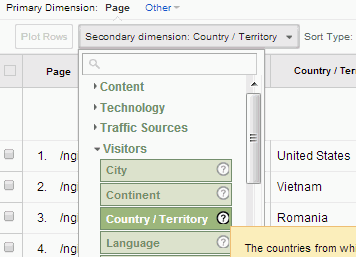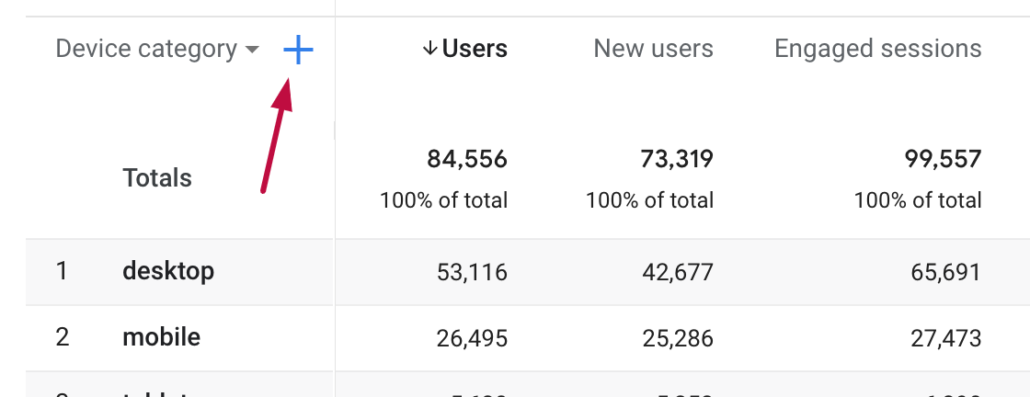Step-by-Step Overview: Leveraging Secondary Dimension in Google Analytics
Step-by-Step Overview: Leveraging Secondary Dimension in Google Analytics
Blog Article
Gain Comprehensive Perspectives With Secondary Dimension in Google Analytics
Secondary measurements in Google Analytics function as an effective tool for enhancing the deepness of insights stemmed from information evaluation. By including additional measurements into your records, you open a world of opportunities for discovering elaborate relationships and nuanced patterns within your internet site's efficiency metrics. This additional layer of information can light up covert fads and provide an extra granular understanding of customer habits. With the capability to segment and contrast information throughout several dimensions, the capacity for getting workable understandings is substantial. Stay tuned to find how secondary dimensions can reinvent your information evaluation and drive notified decision-making in the electronic realm.
Understanding Secondary Dimensions in GA
Secondary dimensions allow users to delve deeper into their data by adding an added layer of details to the primary data being evaluated. By integrating additional dimensions, individuals can sector and contrast information across various dimensions, such as website traffic resources, customer tools, geographical places, and more.
Understanding exactly how to effectively use additional measurements in Google Analytics is necessary for removing valuable understandings from the information gathered. By selecting the appropriate additional measurements to complement main metrics, customers can uncover patterns, fads, and relationships that may have otherwise gone undetected. This deeper degree of evaluation can cause even more enlightened decision-making and the optimization of digital marketing strategies to boost total performance.
Benefits of Making Use Of Additional Dimensions
Exploring the advantages integral in leveraging second measurements within Google Analytics lights up the depth of insights readily available for enhancing data evaluation. By incorporating secondary dimensions, individuals can gain a much more detailed understanding of their key information metrics.
Additionally, additional measurements make it possible for users to compare and contrast different information points within the exact same record, providing a more all natural sight of web site efficiency. This comparative evaluation can clarify the performance of marketing projects, material engagement, or customer demographics. In addition, the usage of second dimensions can aid in recognizing outliers or abnormalities that might need further investigation.
Fundamentally, leveraging secondary measurements in Google Analytics uses a powerful device for extracting beneficial understandings and enhancing data-driven decision-making processes.
Implementing Additional Dimensions Successfully
To properly apply additional measurements in Google Analytics, strategizing the option and application of these extra data layers is vital for making best use of the deepness of insights obtained from analytics records. When selecting second measurements, think about the particular objectives of your evaluation to ensure the selected dimensions align with the info needed to address essential inquiries. It's important to prioritize relevance over amount, choosing measurements that complement the main measurement and supply meaningful context.
Applying secondary dimensions effectively entails utilizing them to discover patterns, patterns, and relationships that might not be noticeable when evaluating data solely based on the key dimension. By integrating additional dimensions thoughtfully, you can boost the granularity of your evaluation and gain deeper understandings into user actions, material efficiency, and various other vital metrics within Google Analytics.
Studying Data With Secondary Measurements
Utilizing second dimensions in data evaluation gives a nuanced perspective that reveals elaborate partnerships and patterns within Google Analytics records. By including additional measurements alongside primary measurements, experts can dig deeper into the information to extract important insights. This strategy allows the identification of connections that might not be instantly noticeable when examining information exclusively based upon main measurements.
When analyzing information with additional measurements in Google Analytics, it is crucial to think about the specific metrics or measurements that will certainly provide one of the most meaningful context for the primary dimension being assessed. For instance, matching the key dimension of 'website traffic resource' with secondary dimensions such as 'gadget group' or 'touchdown web page' can supply an extra detailed understanding of customer habits and choices.
In addition, the capacity to sector data using additional dimensions enables an extra granular examination of individual interactions, helping in the optimization of marketing techniques, website efficiency, and overall user experience. By leveraging additional dimensions properly, companies can make educated decisions based upon a complete analysis of their Google Analytics data.
Ideal Practices for Secondary Measurements
When carrying out additional measurements in Google Analytics, precision in picking appropriate metrics is extremely important for deriving workable understandings from the information evaluation process. One of the ideal practices for using additional measurements efficiently is to straighten them with your main measurement to gain a more extensive understanding of your internet site or project performance. As an example, if your key Secondary Dimension in Google Analytics dimension is 'Source/Medium,' pairing it with second dimensions like 'Tool Group' or 'Landing Web page' navigate to these guys can provide understandings into exactly how various devices or landing web pages impact web traffic from different resources.

Frequently explore various combinations of main and secondary measurements can help you discover brand-new connections and trends within your data, enabling you to optimize your strategies and boost general performance (Secondary Dimension in Google Analytics). By complying with these best practices, you can take advantage of second dimensions in Google Analytics properly to get much deeper understandings and make data-driven choices that positively affect your company

Conclusion
Finally, second dimensions in Google Analytics offer an important opportunity to get deeper understandings into main information metrics. By including a second measurement to records, businesses can discover relationships, trends, and patterns that might not be quickly evident, leading to an extra thorough understanding of user actions and interactions on a site. Carrying out secondary dimensions properly and assessing information with them can help companies make data-driven decisions and maximize their on-line efficiency.
By incorporating second measurements, individuals can section and contrast data across different measurements, such as website traffic resources, customer gadgets, geographical places, and more. Implementing second measurements successfully includes using them to discover patterns, trends, and connections that may not be obvious when analyzing data only based on this contact form the main dimension. By integrating second measurements alongside primary measurements, experts can dig deeper into the information to draw out valuable understandings. One of the finest techniques for using secondary measurements effectively is to align them with your primary measurement to gain a much more thorough understanding of your website or project efficiency. If your main measurement is 'Source/Medium,' coupling it with second dimensions like 'Gadget Classification' or 'Landing Web page' can give understandings right into exactly how different tools or touchdown web pages effect website traffic from different resources.
Report this page